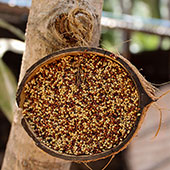Design Resource
Coconut Shell Bird Feeder - Kanyakumari
Utility thing out of waste
by
Prof. Bibhudutta Baral and Rakshitha
Humans have been feeding birds for a very long time. In the Old Testament of the Bible, a passage talks about leaving behind some of the harvests for the birds to collect. Possibly this was the root of the custom to put out bundles of wheat for the birds. The activity of feeding birds has become a favored pastime for many. The joyful chirping of birds all around creates a relaxing sound. It is an excellent form of relaxation and serves to relieve stress. This entertaining activity can be shared by children and adults everywhere. It also teaches young ones to take care of birds and animals. Feeding birds provide us the pleasure and satisfaction of helping them survive and thrive, especially when the weather is less than hospitable.
Personal gardens with bird feeders and bird houses play a significant contribution to protect wild birds. A bird feeder is a container placed outdoors for the birds to feed on bird seed. Bird feeding is a popular and convenient way to observe birds closely. Sometimes, the cameras are fixed near the bird feeder for bird watching and observing nature's wonders. Many types of feeders are available commercially, and some basic designs can be made at home. Simple seed feeders can be made from recycled materials such as empty milk cartons, wood planks, coconut shells, or other containers. Coconut shell is one material that can be used for making a bird feeder. Buddha Handicrafts from Kanyakumari, Tamilnadu, is a place where coconut shells are recycled and used for making bird feeders.
Coconut shells are eco-friendly and readily available. Artists reuse these shells by processing them. Shells are used as a container for bird seeds. They are scrapped, polished, and the ready-to-use seed bars put into them. A rope loop is attached to the shell to hang it outdoors. A natural bird feeder attracts birds to eat seeds. Buddha Handicrafts provides employment opportunities to women artist utilizing their leisure time.





